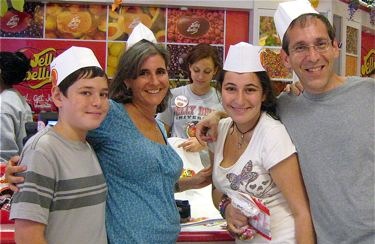
It was a rainy afternoon in Freiburg
on the last day of our recent family vacation in Europe. It seemed a
shame to stay cooped up indoors despite the thundering skies outside.
Our German/Israeli friend Chana who, along with her three kids, was
visiting her brother, had a suggestion.
Â
“Why don’t we go to the pool?†she said.
Â
Now the last thing I would think about doing in the rain is going swimming. But this was no ordinary pool. The Keidel Thermalbad is like soaking in a warm bath…for hours. The effect was extraordinary.
As we luxuriated in the relaxing mineral waters, alternating between
the Jacuzzi jets, the hot and hotter tubs, and the warm water “riverâ€
that spun us round and round in blissful glee, cold rain pelted our
faces from above. And we couldn’t care less.
Â
The Thermal Baths were only the last of a fabulous two week “road tripâ€
in Europe that packed in so much it felt more like two months. We
started near Verona, Italy, at a bed and breakfast built into an old farm house. My morning run that week was something straight out of a Diane Lane movie, with church bells ringing in the distance and everything.
Â
We explored the castle town of Bergamo, rode the cable car to the top of Mount Baldo before exploring the medieval streets of charming Malcesine with its picturesque Castello
below, and waxed poetic on a tour of the lavish Villa Serbelloni in
Bellagio which calls itself – with full justification – one of the most beautiful cities in the world. Shabbat, we were with Chabad in
Venice where we were fed three meals (for free, donation requested) along the
canals just outside the historic Jewish Ghetto.
Â
Then it was off for a few days of hiking in the Swiss Alps. My wife Jody and I had done this twenty years ago as
backpackers and had long dreamed of sharing the majesty of these
stunning mountains with our kids.
Â
From the moment we opened the curtains in our youth hostel in
Grindelwald to the staggering image of the north face of the Eiger
Mountain on our first morning there, to looking down from the snowy wilderness of the Jungfrau‘s 3800 meters
at the rolling green valleys below, I couldn’t help wonder: was this
real or were we standing in front of some extravagant painted backdrop.
Â
A few days in Freiburg touring the Black Forest, and then we flew back to Israel.
Â
The view from the airplane window momentarily stunned me.
Â
After two weeks of conditioning to expect forests and hills and snow
covered peaks, Israel appeared small, flat, brown and dirty.
Â
The effect was not softened any by our taxi driver who tailgated and
swerved past cars and trucks on the road back to Jerusalem far worse
than any of the so-called daredevil Italian drivers we met on the
Autostrada.
Â
The news was no less disorienting. We had been away during the main
week of the disengagement. The TV was still showing images of
army and police carrying Gush Katif residents from the roofs of their
homes. Newspaper headlines screamed in urgency. As the taxi drove past
the Mahane Yehuda shuk, I was struck by how third world Israel still is.
Â
And I thought to myself: what the heck are we doing here?
Â
This is not the first time returning to Israel after vacation has
brought up feelings of culture shock. And I know that there are many
beautiful locations in Israel – the Golan Heights and Upper Galilee have the hills (not to mention Mitzpe HaYamim, my favorite resort), while the Negev is incomparably stunning in that desert
kind of way. We have our own Thermal Baths too, plus waterfalls and
even a fat cow or two lolling on a hillside.
Â
But come on, let’s not kid ourselves. When it comes to sheer physical
beauty, Israel just can’t hold a bar of chocolate to Switzerland and
the Alps.
Â
“How can you say that?†now fourteen-year-old Amir protested as I voiced my observations. “You’re being unpatriotic!â€
Â
I prefer to think of it as stating the facts. I mean, hey God, would it
have been so hard to put a nice little snow-capped Jungfrau just
outside of Tel Aviv? A few rolling “Teletubbies†hills near Ma’aleh
Adumim?
Â
But we already had the answer. It had been taped up on the wall of the elevator that led to our holiday apartment in Freiburg.
Â
I almost didn’t notice it at first. It looked like the kind of notice
that tells you the maximum weight and number of occupants the elevator
can hold. Except that written in small letters near the bottom was the
word “Auschwitz.â€
Â
I took a closer look.
Â
The paper recorded that a Jew named Robert Burgheimer, born August 20,
1882, had lived in this building at 29 Klarastrasse until his
deportation in 1940 to Gurs France and then ultimately to the concentration camp where he was killed along with nearly 300 other Jews from Freiburg.
Â
The note, we found out later from the owners of the building, was part
of a project taken on by a private individual to document where the
Jews had lived prior to the end of World War II. There were similar
documents posted throughout Freiburg.
Â
Now, I know there are some people who are uncomfortable even visiting
Germany. That’s not our case. And Chana’s family went out of their way in showing us the most
heartfelt hospitality.
Â
Still, the whole incident gave me the creeps. It’s an in-your-face
reminder that one cannot – and should never – forget the role that
history plays in determining where we choose to live and make a
community. A simple piece of paper helps put into perspective why we
would choose a flat, brown and dirty piece of land over a continent
filled with glaciers, medieval villages and Swiss chocolate.
Â
Europe is a great place to visit. I’d go back to the Keidel Thermal Baths in a flash. But there’s no place like home.
————————
Here’s the note posted on the elevator wall:



{ 2 comments… read them below or add one }
Mrs. Chaya-Baila Spira writes:
6 million European Jews were killed.
x number of them were Italian.
y number of them were from this town/city and here are their names and ages:
and it goes on to list all the names.
The plaques we saw also had wreaths of dried flowers around them. We saw them in the Padova Cemetary (where the bones of the Abarbanel are buried together with his son's), we saw them in the various synagogues in Rome and Florence and Venice.
Lisa writes: